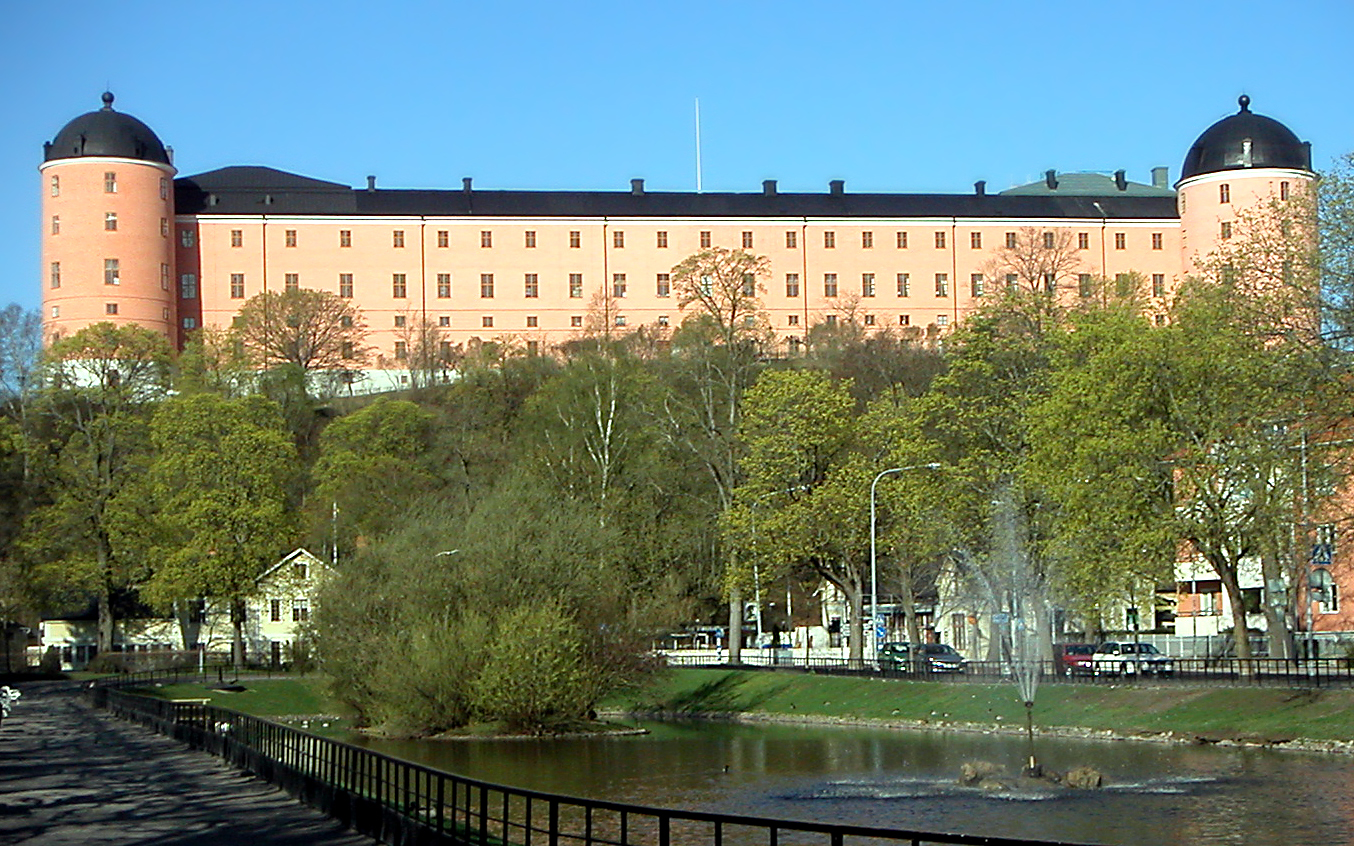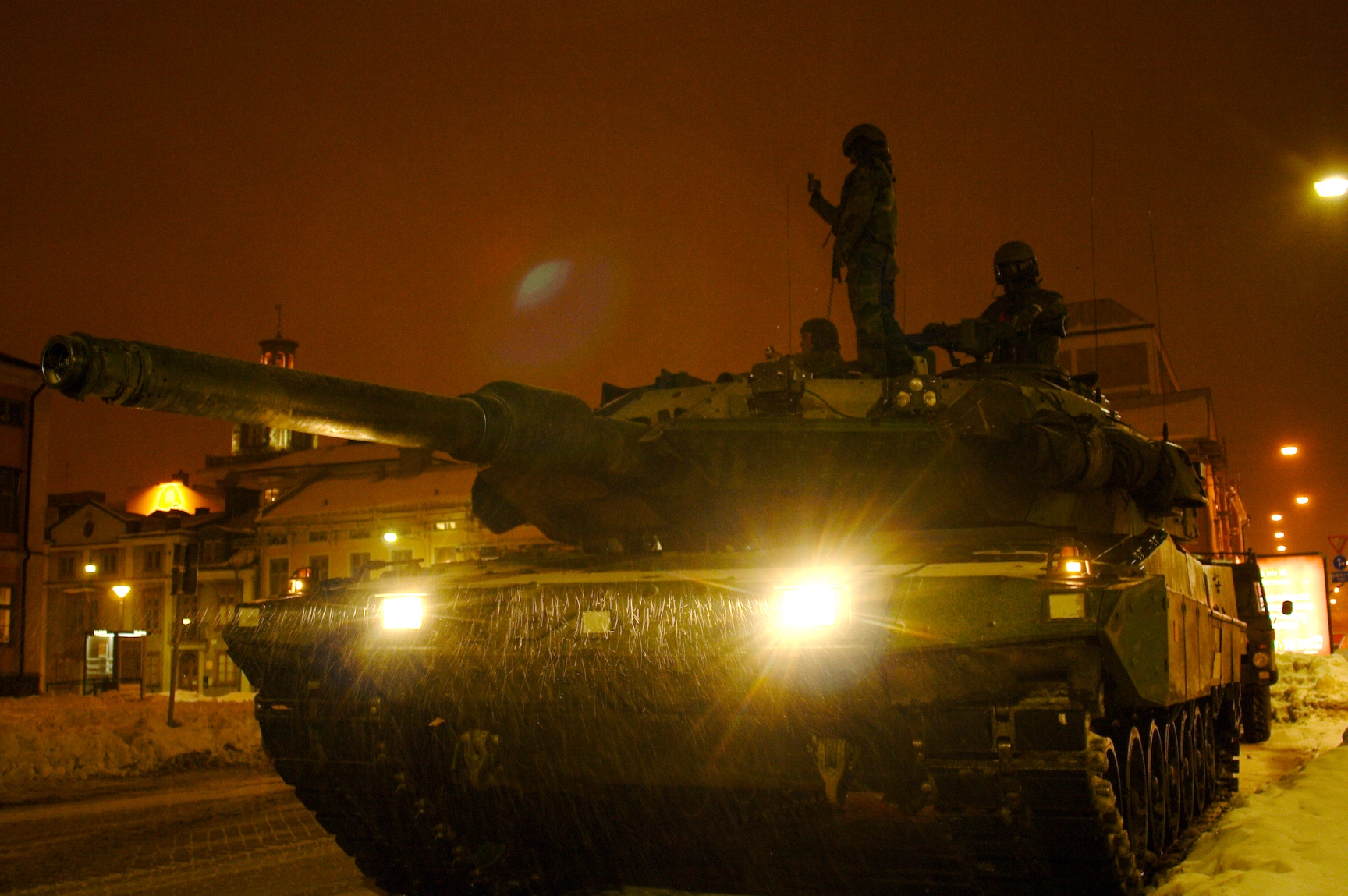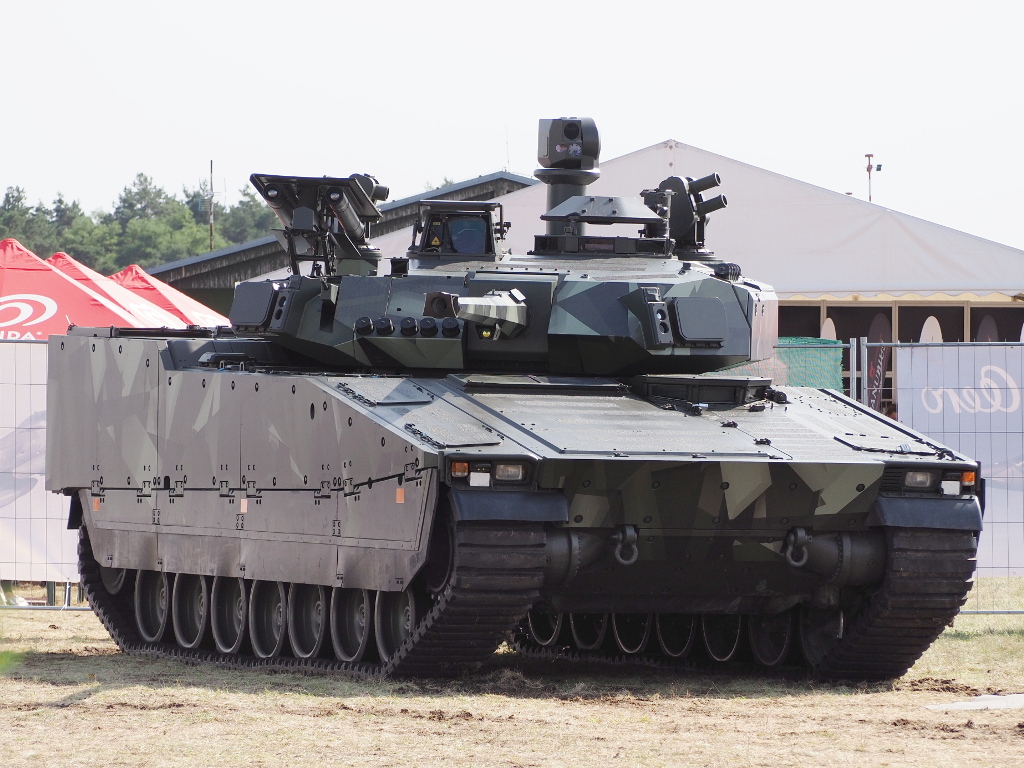|
Life Guards Brigade
The Life Guards Brigade (), or the 1st Infantry Brigade (IB 1), is a reduced Swedish Army infantry brigade located in the county of Stockholm, active since 2024. It was previously active 1949–2000. The brigade is headquartered at Kungsängen Garrison with the Life Guards Regiment. History The brigade was established in 1949 as the peacetime subordinate of the Uppland Regiment under the name Uppland Brigade, with Roslagen as its area of responsibility. However in 1957, the Uppland Regiment was disbanded, and the brigade was transferred and would henceforth act as the peacetime subordinate to the Svea Life Guards instead. In the Defence Act of 2000, the government proposed that the army undergo further post–Cold War downsizing and that many brigades, including the Life Guards Brigade, be disbanded. Upon the re-establishment of the brigade in 2024, its wartime organization would be within the 1st Division along with the rest of the Swedish Army's active brigades. The briga ... [...More Info...] [...Related Items...] OR: [Wikipedia] [Google] [Baidu] |
Life Guards (Sweden)
The Life Guards (, designation LG) is a combined Swedish Army cavalry/infantry regiment. Its responsibilities include the defence of Stockholm as well as provision of the royal guard of honour for the King of Sweden and the Stockholm Palace. With traditions dating from 1521, the regiment is one of the List of oldest military units and formations in continuous operation, oldest military units in continuous operational existence in the world. It was established in its present form in July 2000, following a merger of the Svea Life Guards and the Life Guard Dragoons (Sweden), Life Guard Dragoons. Headquarters are mainly located in Brunna north of Kungsängen in Upplands-Bro Municipality and at the "Cavalry Barracks 1" in central Stockholm. History Svea Life Guards dates back to the year 1521, when the men of Dalarna chose 16 young able men as body guards for Gustav Vasa, thus making the Life Guards List of oldest military units and formations in continuous operation, one of the worl ... [...More Info...] [...Related Items...] OR: [Wikipedia] [Google] [Baidu] |
Defence Act Of 2000 (Sweden)
The Defence Act of 2000 (prop. 1999/2000:30) was a defence act passed by the Swedish Riksdag on 30 March 2000, and the largest reorganisation of the Swedish Armed Forces since the Defence Act of 1925. The act was a continuation of the policies set in motion by the Defence Act of 1996: shifting the military's focus from the defence of Swedish territory to a more flexible "operational defence* (Swedish: ''insatsförsvar'') for smaller-scale peacekeeping operations in foreign nations. Many military formations were disbanded as a result. Summary The future organisation decided by the act included, up until 2004, the following military units: * A headquarters, an operational command, and four military district commands. * An army divisional command, formed of an NBC task force and two rifle battalions. * 6 army brigade commands, 16 mechanised battalions, 4 air defence battalions, 4 howitzer battalions, 4 pioneer battalions, 4 maintenance battalions, 6 urban warfare battalions and ... [...More Info...] [...Related Items...] OR: [Wikipedia] [Google] [Baidu] |
Kungsängen
Kungsängen () is a locality and the seat of Upplands-Bro Municipality, Stockholm County, Sweden Sweden, formally the Kingdom of Sweden, is a Nordic countries, Nordic country located on the Scandinavian Peninsula in Northern Europe. It borders Norway to the west and north, and Finland to the east. At , Sweden is the largest Nordic count ..., with 9,382 inhabitants in 2010. References Populated lakeshore places in Sweden Populated places in Upplands-Bro Municipality Municipal seats of Stockholm County Swedish municipal seats {{Stockholm-geo-stub ... [...More Info...] [...Related Items...] OR: [Wikipedia] [Google] [Baidu] |
Uppsala
Uppsala ( ; ; archaically spelled ''Upsala'') is the capital of Uppsala County and the List of urban areas in Sweden by population, fourth-largest city in Sweden, after Stockholm, Gothenburg, and Malmö. It had 177,074 inhabitants in 2019. Located north of the capital Stockholm, it is also the seat of Uppsala Municipality. Since 1164, Uppsala has been the ecclesiology, ecclesiastical centre of Sweden, being the seat of the Archbishop of Uppsala, Archbishop of the Church of Sweden. Uppsala is home to Scandinavia's largest cathedral – Uppsala Cathedral, which was the frequent site of the coronation of the Swedish monarch until the late 19th century. Uppsala Castle, built by King Gustav I of Sweden, Gustav Vasa, served as one of the royal residences of the Swedish monarchs, and was expanded several times over its history, making Uppsala the secondary capital of Sweden during its Swedish Empire, greatest extent. Today, it serves as the residence of the Governor of Uppsala County ... [...More Info...] [...Related Items...] OR: [Wikipedia] [Google] [Baidu] |
Sverker Göranson
General Sverker John Olof Göranson (born 3 May 1954) is a retired Swedish Army officer. Sverkerson was commissioned as an officer in 1977. During the 1990s, Göranson embarked on an international career. He completed the Swedish National Defence College's Command Course and attended several courses in international humanitarian law before relocating to the United States Army Command and General Staff College in Fort Leavenworth, Kansas. In 1994, he also completed the United Nations Staff Officers Course. Notably, Göranson served as the Chief of Staff in Nordbat 2/BA 05 within the United Nations Protection Force (UNPROFOR) in Bosnia from 1995 to 1996 and later as the Deputy Battalion Commander in Swebat within the Implementation Force (IFOR) in Bosnia and Herzegovina in 1996. Upon his return to Sweden, Göranson assumed the position of Deputy Brigade Commander at the Scanian Brigade and later became the Brigade Commander of the Life Guards Brigade before taking up the role of Mi ... [...More Info...] [...Related Items...] OR: [Wikipedia] [Google] [Baidu] |
Johan Hederstedt
General Johan Ivar Hederstedt (born 26 August 1943) is a senior Swedish Army officer. Hederstedt was commissioned as an officer in 1966 and went on to serve as a second lieutenant in the Älvsborg Regiment. In 1981, he embarked on a United Nations mission to the volatile region of Cyprus, a commitment that was followed by another overseas assignment in 1988 when he assumed command of a UN battalion in Lebanon. Throughout the 1990s, Hederstedt held various significant roles within the military, including serving as the brigade commander of the Life Guards Brigade, the commander of the Western Army Division, the deputy chief of the operations leadership for international operations, and a military expert at the Ministry of Defence. In the year 2000, he assumed the position of Supreme Commander of the Armed Forces. Remarkably, his tenure in this role lasted only three years, making him the shortest-serving Supreme Commander in history. In the wake of the defence budget cuts during ... [...More Info...] [...Related Items...] OR: [Wikipedia] [Google] [Baidu] |
Strv 122
Stridsvagn 122 (strv 122, ) is a Swedish main battle tank that, like the German Leopard 2A5, is based on the German Leopard 2 Improved variant using such newer technology as command, control, and fire-control systems, reinforced armour, and long-term combat capacity. Externally, the vehicle is distinguished from the Leopard 2A5 by the French GALIX smoke dispensers, different storage bins, and the thicker crew hatches. Development After the strv 2000 project for a new Swedish main battle tank was cancelled, the Swedish government decided in 1991 that a foreign main battle tank was to be procured to replace the Strv 101, 102, 103 and 104 in service at the time. During the project "Strv Ny", three tank models were sent to Sweden to participate in trials: the American M1A2 Abrams, the German Leopard 2 Improved, and a prototype variant of the French Leclerc. The trials concluded with the Leopard 2 approved as the winner and the M1A2 in second place. The shortcomings of the L ... [...More Info...] [...Related Items...] OR: [Wikipedia] [Google] [Baidu] |
Strf 90
The Combat Vehicle 90 (CV90) (, strf 90 or Stridsfordon 90) is a family of Swedish tracked armoured combat vehicles designed by the Swedish Defence Materiel Administration (FMV), Hägglund & Söner and Bofors during the mid-1980s to early 1990s, before entering service in Sweden in the mid-1990s. The CV90 platform design has continuously evolved from the Mk 0 to the current Mk IV with technological advances and changing battlefield requirements. The Swedish version of the main infantry fighting vehicle (IFV) is fitted with a turret from Bofors equipped with a 40 mm Bofors autocannon. Export versions are fitted with Hägglunds E-series turrets, armed with either a 30 mm Mk44 or a 35 mm Bushmaster autocannon. Over time, the involvement of Hägglund & Söner has been superseded by Alvis Hägglunds (from 1997) and BAE Systems Hägglunds (from 2004). Developed specifically for the Nordic subarctic climate, the vehicle has very good mobility in snow and wetlands while c ... [...More Info...] [...Related Items...] OR: [Wikipedia] [Google] [Baidu] |
Armoured Personnel Carrier
An armoured personnel carrier (APC) is a broad type of armoured military vehicle designed to transport personnel and equipment in combat zones. Since World War I, APCs have become a very common piece of military equipment around the world. According to the definition in the Treaty on Conventional Armed Forces in Europe, an APC is "an armoured combat vehicle which is designed and equipped to transport a combat infantry squad and which, as a rule, is armed with an integral or organic weapon of less than 20 millimetres calibre." Compared to infantry fighting vehicles (IFVs), which are also used to carry infantry into battle, APCs have less weapon, armament and are not designed to provide direct fire support in battle. Infantry units that travel in APCs are known as mechanized infantry. Some militaries also make a distinction between infantry units that use APCs and infantry units that use IFVs, with the latter being known as armoured infantry. History One of the first armored ve ... [...More Info...] [...Related Items...] OR: [Wikipedia] [Google] [Baidu] |
Stockholm
Stockholm (; ) is the Capital city, capital and List of urban areas in Sweden by population, most populous city of Sweden, as well as the List of urban areas in the Nordic countries, largest urban area in the Nordic countries. Approximately 1 million people live in the Stockholm Municipality, municipality, with 1.6 million in the Stockholm urban area, urban area, and 2.5 million in the Metropolitan Stockholm, metropolitan area. The city stretches across fourteen islands where Mälaren, Lake Mälaren flows into the Baltic Sea. Outside the city to the east, and along the coast, is the island chain of the Stockholm archipelago. The area has been settled since the Stone Age, in the 6th millennium BC, and was founded as a city in 1252 by Swedish statesman Birger Jarl. The city serves as the county seat of Stockholm County. Stockholm is the cultural, media, political, and economic centre of Sweden. The Stockholm region alone accounts for over a third of the country's Gros ... [...More Info...] [...Related Items...] OR: [Wikipedia] [Google] [Baidu] |
Svea Life Guards
The Svea Life Guards (), also I 1, was a Swedish Army infantry regiment that was active in various forms 1521–2000. The unit was based in the Stockholm Garrison in Stockholm and belonged to the King's Life and Household Troops (''Kungl. Maj:ts Liv- och Hustrupper'') until 1974. History 1500s–1900s Svea Life Guards, the Swedish Army's first guard infantry regiment, originated from the Trabant Corps that surrounded the first Vasa Kings and is said to have been formed in 1526. The Trabant Corps seems to have, at least in part, been included in the enlisted regiment established in 1613, which consisted mostly of Germans, which under the names of the King's Life and Court Regiment (''Konungens liv- och hovregemente''), the Yellow Regiment (''Gula regementet'') and the Yellow Brigade (''Gula brigaden'') participated in Gustavus Adolphus' campaign in Germany. The regiment's first two companies formed the king's lifeguard and consisted mostly of Swedes. The 60 survivors of the gu ... [...More Info...] [...Related Items...] OR: [Wikipedia] [Google] [Baidu] |
1st Division (Sweden)
The 1st Division () is a Swedish Army Mechanized infantry, mechanized Division (military), division located in the county of Västra Götaland County, Västra Götaland, active since 2022. It was previously active 2000–2004. The division is Headquarters, headquartered at Skövde garrison with the Skaraborg Regiment (armoured), Skaraborg Regiment. History In the Defence Act of 2000 (Sweden), Defence Act of 2000, the government proposed that the three remaining army divisions, following post–Cold War downsizing, be consolidated into a single, reinforced division to reduce bureaucracy within the army. The Swedish Parliament ultimately approved the proposal, leading to the creation of the 1st Mechanized Division as the successor to the Upper Northern Army Division, the Eastern Army Division, and the Southern Army Division. The new division, however, lasted only four years. In the Defence Act of 2004, the government proposed that the division be disbanded and its unit be placed d ... [...More Info...] [...Related Items...] OR: [Wikipedia] [Google] [Baidu] |





